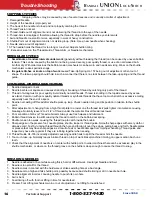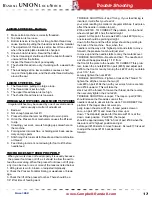
R
andall
UnIOn
l
Ock
-S
tItch
Timing
Since 1858
Since 1858
www.Campbell-randall.com
13
T
IMINg
OF
The
U
NION
L
OCkSTITCh
C
OURSe
A
djUSTMeNT
T
IMINg
NOTE: Do not make changes to the coarse adjustment unless there
is insufficent movement to allow normal fine adjustments to the
shuttle and needle timing.
•
on the top right of the machine you will see a cut-out that allows
access to adjust the gear UL-57. This is the main timing point
to synchronize the the upper section (awl, thread guide, looper,
take-up, and foot lift motion) with the lower section (needle, feed,
and shuttle motion)
WHEN NECESSARY,
timing is accomplished as follows:
1.
Turn the balance wheel so that the take-up, (Ul-135/Ul-141), is
at its highest point before it begins to drop.
2.
loosen the set screws on the bevel gear (Ul-57) until is can
slide on the horizontal shaft (Ul-50) and disconnect it from the
gear on the vertical shaft. This will allow the top of the machine
to work freely without motion in the bottom of the machine.
3.
hold gear Ul-57 so it will not turn and, at the same time, using a
wide blade screw driver to pry against the teeth, turn the shuttle
shaft driving gear Ul-72. Do noT loosen the set screws. Make
one complete cycle, then bring the ascending needle
barb
point
to 1/4’” below the lower surface of the throat plate. As another
reference, the tip of the needle is 1/16” to 1/8” below the cut out
in the stitching plate (part Ul-250*). This is where the bottom
portion of the machine needs to be set.
4.
Move the gear Ul-57 back to its engaged position with the
vertical shaft gear, leaving a very small amount of play between
the two gears. Make certain that the set screws are both over
the flat spots on the shaft which may require the removal of the
set screws to locate, which are 90° to each other. Tighten one
set screw, then recheck the timing. If this is correct then set both
screws snug with a “T” wrench and pliers. If the balance wheel
moves when you tighten these screws, then the gear is not set
directly on the flats and it should be reset.
Shuttle Point Alignment - R
IghT
TO
L
eFT
• The needle should be on center with the shuttle point (UL-276).
• If the needle is straight, align the needle to the center of the shuttle point by adjusting the two screws on either side of the
shuttle housing (Ul-235).
• Loosen the screws and slide the shuttle to the left or right of the operator.
• NOTE: Make sure that the hook of the needle, directly faces the operator. If the hook on the needle is slightly turned, it
will cause skipping or breaking of the thread.
feed of the Needle in relation to the foot
•
One way of knowing if the feed is out of adjustment, is that the stitches will suddenly get very small. This is because the
foot is not lifting and allowing the work to be pulled.
•
Just as the needle is at its highest position, just as it begins to pull back on the work, the foot should begin to lift. The
needle should feed all the way back and begin to drop when the foot begins to drop.
•
The adjustment is behind the UL-226 bolt that you used for determining the stitch length. Inside on the lower shaft is
cam UL-219. This is not a normal adjustment, so please contact Randall before changing.
•
when the bell (Ul-214) is upward, the Ul-219 feed cam eccentric screws (Ul-220) should be in a position where one is
in a downward position and the other facing the back of the machine.
•
NOTE: The feed timing will affect the adjustment of the UL-165 Thread Guide and UL-180 Thread Looper





































